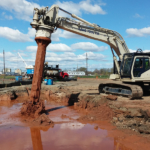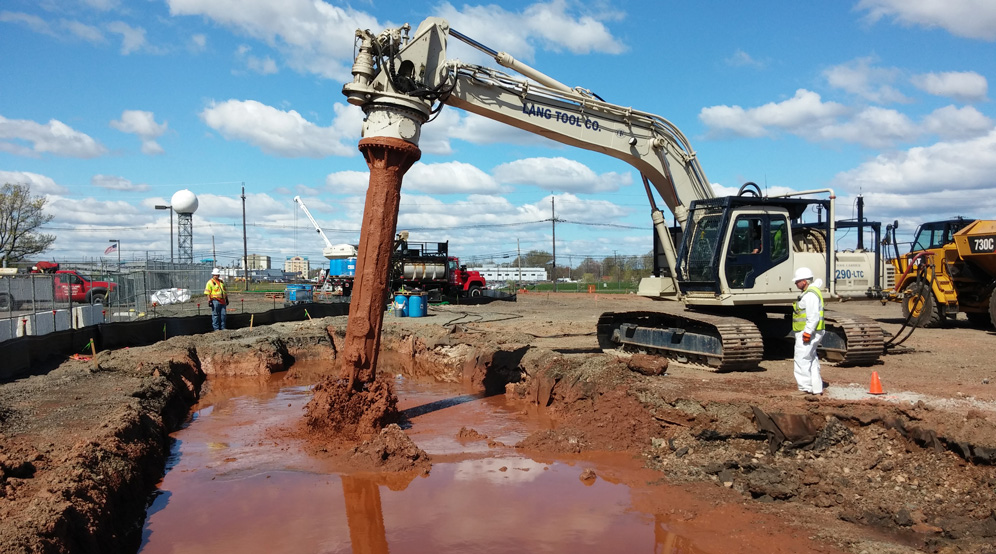In-Situ Chemical Oxidation
OVERVIEW
Langan and Viasant performed an in-situ chemical oxidation (ISCO) entailing soil mixing of iron-activated persulfate at a site located in Northern New Jersey. The large-scale soil mixing activities were completed in April and May 2015.
Langan performed a bench-scale treatability study that evaluated three different persulfate activation methods: 1) sodium hydroxide activation, 2) quick lime activation, and 3) iron activation. Iron did not need to be added because of abundant the iron mineral magnetite in the site soil. Based on the treatability test results, soil mixing with iron activation using natural iron and additional iron-EDTA was selected for field implementation.
Under Langan oversight, Viasant completed ISCO remedial implementation consisting of blending approximately 150,000 pounds of sodium persulfate, 110,000 pounds of 25% sodium hydroxide, and 1,000 pounds of iron-EDTA into a 7,000-cubic-yard mixing volume over 13,500 square feet. A dual-axis mixing head enabled even and precise mixing and dosing. The clean overburden was removed before mixing and backfilled after mixing. Before final backfilling, the top 1-foot mixing zone was stabilized with cement to increase the soil strength.
The Langan/Viasant team implemented innovative risk management procedures to ensure success. Field treatability tests were conducted on-site daily to confirm the dosages buffer reagent (sodium hydroxide), because the rapid activation and reaction drove the soil pH lower during mixing. Samples were taken from each cell upon mixing completion, and their persulfate residual concentrations, pH, and iron levels were measured and evaluated against performance criteria immediately. The mixing cells that failed the criteria were remixed till performance criteria were met.
The performance monitoring results showed that target contaminants were reduced significantly without rebound after one year. Adequate dosage and complete contact results in the successful reduction.
Langan performed a bench-scale treatability study that evaluated three different persulfate activation methods: 1) sodium hydroxide activation, 2) quick lime activation, and 3) iron activation. Iron did not need to be added because of abundant the iron mineral magnetite in the site soil. Based on the treatability test results, soil mixing with iron activation using natural iron and additional iron-EDTA was selected for field implementation.
Under Langan oversight, Viasant completed ISCO remedial implementation consisting of blending approximately 150,000 pounds of sodium persulfate, 110,000 pounds of 25% sodium hydroxide, and 1,000 pounds of iron-EDTA into a 7,000-cubic-yard mixing volume over 13,500 square feet. A dual-axis mixing head enabled even and precise mixing and dosing. The clean overburden was removed before mixing and backfilled after mixing. Before final backfilling, the top 1-foot mixing zone was stabilized with cement to increase the soil strength.
The Langan/Viasant team implemented innovative risk management procedures to ensure success. Field treatability tests were conducted on-site daily to confirm the dosages buffer reagent (sodium hydroxide), because the rapid activation and reaction drove the soil pH lower during mixing. Samples were taken from each cell upon mixing completion, and their persulfate residual concentrations, pH, and iron levels were measured and evaluated against performance criteria immediately. The mixing cells that failed the criteria were remixed till performance criteria were met.
The performance monitoring results showed that target contaminants were reduced significantly without rebound after one year. Adequate dosage and complete contact results in the successful reduction.


